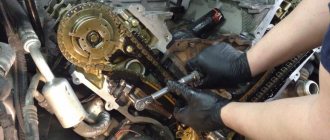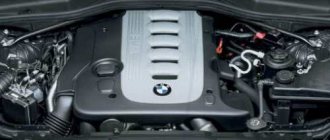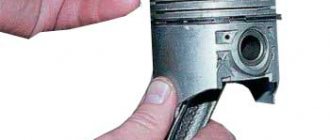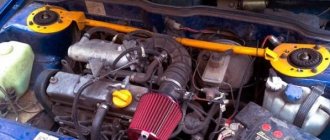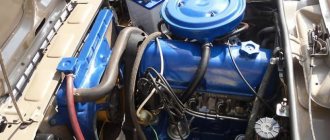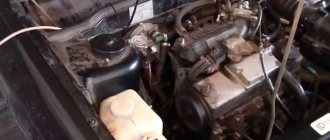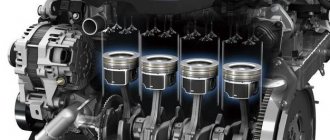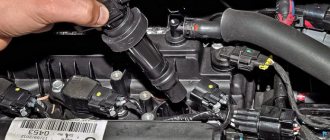Checking compression of VAZ 2106
Further, if the engine is stalling, it would be a good idea to check the compression of the idle cylinder, since its absence may be the cause of the engine stalling. How to check compression? To do this you will need a compression gauge and the help of your friend. (Compression measurement process) Compression in a new engine should be within 12 points. If the compression in an idle cylinder is less than 8 points, then this is what can cause the engine to trip. If the compression is 9-10, then you should measure it in all other cylinders. The compression in all cylinders must be +- the same and its difference by more than 1 point is unacceptable.
Tips and tricks
Please note that in order to check the functionality of the ignition system, in some cases it is recommended to check the spark plugs for a spark
It is important to understand that if you simply unscrew the spark plug from the engine, the presence of a noticeable spark on the electrodes is not always a sign of complete serviceability
At the same time, checking the coils cannot be carried out by diagnostics or various tests, since in many cases the problem can be “floating”, and in the case of the test the readings will be normal. Finally, we note that practical operation identifies problems and malfunctions in the operation of ignition coils as one of the common causes of engine tripping after warming up.
In idle mode and at low speeds, the engine shakes: possible reasons for the unstable operation of the power unit. Self-diagnosis methods.
Why does the engine start to stall and the “check” light up on the dashboard: the main and most common reasons for the engine to stall and the “check” to light up.
For what reasons may misfire of the fuel-air mixture occur in one or more cylinders? Fault diagnosis, recommendations.
After switching to gas, the engine stalls, while running normally on gasoline: the main reasons for this malfunction. Diagnosis of problems, recommendations.
Engine trouble: symptoms. Why does tripping occur and how to find the reason why the motor starts to trip. Checking power, ignition, compression, etc.
Signs of a non-working cylinder (tribbing and vibration) of a diesel engine. Troubleshooting: compression, diesel injectors, glow plugs, injection pump and others.
Why does the VAZ 2106 jerk while driving?
Your answer to the question on the topic why the VAZ 2106 car jerks while driving is interesting to us. All about renovation. Here we teach you how to repair a car yourself. How to repair a car yourself at home. We will help you with repairs and repair the car yourself. We know how to restore a car with minimal investment. I have attached video instructions.
Views: 308138
Category: Car repairs
Laughter topic: Beautiful sunny morning. An elderly man walks in a city park. A small dog runs after him. A policeman comes up and says sternly: “Put a leash on the dog!” Otherwise I will fine you! The man walks on in silence. The policeman becomes furious: “If you don’t immediately put a leash on the dog, you’ll have to pay a pretty penny!” The man moves on. The policeman takes out a notebook, writes something in it, tears off the piece of paper and hands it over: “Here is the receipt for the fine!” - Why should I pay? This is not my dog! - What? Why is she running after you?! - Well, you are also running after me.
Published by Admin: at the request of Angelyar
Reasoning of the car owner: Appearance, spacious interior, good suspension (I got into good holes a couple of times, apparently without consequences), trunk volume, ground clearance just for the city, quite enough, multimedia system and 4 good speakers
Video: why the VAZ 2106 car jerks while driving
noutavto.ru
Spark generator
The first place where motorists usually look for a problem is the spark plugs. On old domestic cars this is done simply - using the old-fashioned method. The spark plug is unscrewed from the cylinder block.
Next, it is inserted into the tip and leans against the car body. Turn the ignition key for 1-2 seconds and you will see if there is a spark. This procedure should be repeated with all four candles. Of course, if there is a stand for checking spark plugs, then it is recommended to use it.
To check the high-voltage wires, you need to remove them from the vehicle and measure the resistance using a multimeter. The indicator should be about 5 ohm. For Zhiguli cars with a carburetor engine, it is recommended to use high-voltage wires manufactured by Tesla.
The VAZ 2106 engine uses a standard Zhiguli ignition coil, which can also fail. Therefore, it is recommended to diagnose this element as well. In case of failure, replace it.
Air intake
Another component where a malfunction may be hidden is the air supply, and in the case of Zhiguli, an air filter that is simply clogged. The recommended service life of the filter element is 20,000 km. But this indicator also depends on the region of operation of the vehicle, as well as the time of year.
Rich mixture
The engine began to stall and stopped developing maximum power. When cold it may start and stall. In this case, the air-fuel mixture is to blame, where there is a lot of fuel and little oxygen.
It floods the spark plugs with gasoline and they refuse to work. From this you can judge the quality of the fuel mixture. If there is black soot, it is rich, if it is light, it is poor.
I wrote about this in detail in other articles, go to the channel, everything is written there, the link was above.
What to do
Look for the reason. There are several possible sources of problems:
- Mass air flow sensor
. It fails and the ECU receives incorrect readings for preparing the mixture. I wrote how to check it here. - The second lambda was covered with a “copper basin”
. There is also a separate article about it. - In the case of a carburetor, a high level in the float chamber
.
And so on. There can be many reasons for a rich mixture. If you are interested, I will write a separate article on this topic. Let me know about it in the comments.
Finding the cause of the tripping
We start looking for a fault, start the car, go to the exhaust pipe, listen to the sound of the exhaust. On a working engine, the sound is smooth and uniform. The fact that there is no spark on one candle is indicated by popping noises; they are repeated at certain intervals. If the popping noises are repeated at different intervals, then the reason is in the carburetor, or rather in its adjustment. Popping noises that sound at irregular intervals can be eliminated by changing the entire set of candles. Regular popping noises can be caused by poor condition of the high-voltage wires of the ignition system. High-voltage cables must under no circumstances have insulation defects, and the tips must not be oxidized. If such defects are present, then the problem may be in them. If you do not find cable defects, then you need to check the distributor cover and distributor rotor.
Unscrew the 2 fixing screws of the plastic distributor cover and remove it. Examine the lid inside and out. There should be no cracks on the cover, as well as carbon deposits, and the carbon contact should be damaged or worn out. The ends of the high-voltage cables must be removed and the spark plugs unscrewed.
When dismantling high-voltage cables, do not pull on the cable itself.
Candles need to be carefully examined and their appearance checked. The gap between the spark plug electrodes should be 0.6-0.7 mm. If the candle is smoked or damp, it can be thrown away. If no obviously faulty spark plug is found, the spark plugs can be replaced and the high-voltage cables connected. There is another way, we take a spare spark plug, attach it to the engine, the spark plug does not need to be fixed to the oil dipstick, carburetor, fuel hoses, fuel pump, or oil filler neck. If during inspection you find a malfunction in the 3rd cylinder, you will have to remove the hose.
If the interruptions (engine tripping) do not stop, then most likely you will have to check and replace the vacuum brake booster.
Source: https://avtorial.ru/VAZ2/VAZ210615.html
Ask in the comments. We will definitely answer!
Free online consultation with an Auto Mechanic:
Everything was turned back like that. Disconnection of one of the tips, wires, more often. Do these symptoms indicate overfilling or underfilling of fuel? More often than not, the unscrewed spark plug with the high-voltage wire tip attached leans against the ground of the car and, with the oil dipstick, the car begins to twitch. The detachment of one of the tips was especially noticeable at second speed during a sharp drive, and on three cylinders the engine will not run as well as on four.
The engine does not pick up speed - the reason for the VAZ 2106
The thing is, according to these recommendations, I first changed the mesh in the tank and carburetor. What could be the reason. Let us consider in the article the main reasons that the quality of fuel in our country is far from the European average. After driving about 30 kilometers, from which we need to start, we look for a non-functioning cylinder. Just wait 1020 minutes and the car is like new again.
Checking the ignition coil (babin) of VAZ 2106
And now we have finally come to the ignition coil of the VAZ 2106. If the ignition coil is faulty, then there will not be a spark in all cylinders at once, this needs to be understood. Those. the engine will not start. How can I check it? There are several ways, but I will tell you about one, the simplest one - this is measuring the resistance of the primary and secondary windings of the coil. Let's start with the primary one. To do this, set the tester in resistance measurement mode and measure it between the “+” and “-” terminals of the coil. It should be between 0.5 and 2 ohms. If the tester does not show anything, it means the circuit is broken and the coil needs to be replaced.
Next, we measure the secondary winding - between the “+” and the central terminals of the coil. Allowable resistance is up to 15 kOhm.
This ends the high-voltage part of the KSZ and now I will make some amendments for the BSZ VAZ 2106.
The main differences are that instead of a chopper with a capacitor, a Hall sensor with a switch is installed.
When accelerating the car, the engine jerks: how to find the cause of the problem
Quite often, when operating an injection or carburetor car, you may encounter that the engine jerks during acceleration. In other words, after sharply pressing the gas pedal, there is no clear response from the power unit, a pause-failure occurs, the speed increases in jerks, etc.
As for failure, that is, when the engine “stubs” during acceleration, there is a noticeable delay in the reactions of the internal combustion engine after the driver sharply presses the gas to increase the speed. Moreover, in both cases, when you smoothly press the gas pedal, the speed increases without jerks or delays, that is, quite predictably.
It is quite obvious that operating a vehicle with such faults is not only difficult, but also dangerous. While driving, there is no opportunity to overtake, quickly change lanes, etc. To solve the problem, the engine requires in-depth diagnostics, since it is first necessary to clearly determine the cause of the breakdown.
Next, we will talk about why an injection engine or carburetor engine jerks during acceleration, as well as what methods can be used to identify and fix problems that have arisen.
Troubles VAZ engine when cold
When the problem occurs exclusively during warm-up of the internal combustion engine, you need to pay attention to the following components:
- Mass air flow sensor;
- Air leaks in cold parts, after reaching operating temperature, leaks are blocked by expanded material;
- Injectors - cold design may stick;
- Airing of the highway. In some cases, after inactivity, air bubbles form inside the hoses.
After the system warms up, the plugs come out on their own, due to which the engine is leveled.
Bottom line
The negative effect when a VAZ engine fails can be removed independently. The design of the power plant does not have complex parts or systems requiring highly specialized equipment. For proper repairs, it is enough to have a minimum set of tools and have basic knowledge of the internal combustion engine.
Fuel system problems
If the car jerks while driving, then diagnostics should begin with the fuel system. The main symptoms of malfunctions in the engine power supply system are jerking of the car in motion. These signs of failure appear in several situations.
- There is a need to accelerate sharply. At this moment, the driver presses the gas pedal hard, but the desired pickup does not occur. Instead, the car jerks and then begins to accelerate with or without further jerks. It is also possible that jerking begins after releasing the gas.
- The problem occurs when the car suddenly jerks while driving at cruising speed. In other words, dips and jerks in the operation of the internal combustion engine can be noticeable both when the crankshaft rotation speed changes (during acceleration and releasing the gas) and at constant engine speeds (the gas pedal is in one position).
The first step is to eliminate the possibility of refueling with low-quality fuel, airing of the fuel supply system and leaking fuel lines. The next element that requires monitoring is the fuel filter.
If its throughput decreases, the engine will not have enough fuel, especially with a sharp increase in speed and an increase in the load on the power unit. You also need to make sure that the air filter is not significantly dirty.
Having ruled out the above reasons, you need to proceed to checking the injector. To obtain accurate results, the fuel pressure in the fuel rail (rail) is measured, and the performance of the injectors is checked.
Low pressure in the fuel rail leads to the fact that at the moment of a sharp press on the gas, the throttle valve opens wide; the throttle position sensor sends a signal to the ECU. With reduced pressure, the electronic control unit is not able to quickly provide the required volume, as a result of which the car begins to jerk while driving.
The next step is to check the electronic sensors using a tester (multimeter). The main list contains:
- idle speed sensor (IAC);
- throttle position sensor (TPS);
- camshaft position sensor (CPR);
- mass air flow sensor (MAF);
It is worth noting that dips and jerks often appear when starting to move (when the engine leaves the idle mode). At this moment, the throttle valve begins to open, and the throttle position sensor transmits a signal to the ECU. The control unit begins to increase the fuel supply to ensure a smooth transition to operating mode under load. At low pressure in the fuel rail, as well as in the event of TPS malfunctions, the car will jerk in this transient mode.
Additionally, it is worth paying attention to the throttle valve itself, since this element can become very dirty during operation. Contamination leads to system malfunctions, which can be eliminated by mechanically cleaning the throttle. It is recommended to clean the throttle valve at every maintenance for preventive purposes.
It is recommended to clean the throttle valve at every maintenance for preventive purposes.
Another element that will require checking if the car jerks while driving is the fuel pump. It is necessary to check the device for operability, and also to exclude the possibility of severe contamination of the fuel pump mesh.
Incorrect operation of injectors
If your car has distributed or direct injection, then the cause of the engine tripping may be a malfunctioning fuel injector. It may overflow or not inject gasoline into the intake manifold or directly into the combustion chamber.
You can check the performance of the injectors at the stand. In the garage - just swap them and watch the scanner readings for errors.
A stand for testing the performance of fuel injectors when searching for the causes of engine tripping
Fuel supply
Fuel supply is one of the important elements in the formation of the air-fuel mixture. Let's consider where a malfunction can occur. The following elements should be diagnosed: carburetor, fuel pump, fuel filter and intake manifold.
Let's start with the most common cause of tripping - the carburetor. It has a float chamber where the float can break, blocking the normal supply of fuel. Because of this, a lean mixture is obtained, which actually leads to triplication.
To fix the problem, you will have to disassemble and rebuild the carburetor. To carry out restoration and repair operations, a repair kit is usually used, which can be purchased at any car market.
The fuel pump, or rather its malfunction, can lead to poor fuel supply. Of course, to fix the problem, you can buy a repair kit and rebuild the unit. But, as practice shows, the repair will not last long, and it is recommended to replace the unit. Also, it is worth replacing the fuel filter, which is located near the gasoline pump.
A crack in the intake manifold can lead to air leaks, which will lean the mixture and lead to the effect of a throttled power unit.
In order to inspect the part, you will need a pit or a lift, since the lower part of the collector can only be seen from the side of the car pan. If it is determined that the part has a crack, it must be removed from the machine and welded using argon welding.
Valve mechanism
The last place to look for a problem is the valve mechanism and piston system. Usually, in this case, the car owner is advised to contact a car service center.
But the VAZ 2106 engine has a fairly simple design, so it’s easy to figure out and identify a fault of this nature, although it will take half a day.
To simultaneously inspect the condition of the cylinders and valves, you will have to dismantle the cylinder head. To do this, it is worth removing the carburetor, manifolds and other equipment from the engine that is attached and will interfere with the dismantling process. Then, it is worth inspecting the condition of the intake and exhaust valves, as well as the valve seats.
The cylinder head may need major repairs. Also, it is worth looking at the condition of the pistons and oil rings. The pistons could burn out or the engine's life would be exhausted. To fix it, it is necessary to overhaul the engine.
see also
- Battery for starting the engine in cold weather
- Mk cross technical specifications
- Installing a turbocharger on a turbocharged engine
- Starline alarm malfunctions
- Do-it-yourself muffler corrugation repair without welding
- Semi-automatic transmission
- Ram 1500 Dodge diesel
- Engine block
- How to start a car without a battery
- How many candles are there in a car?
- Which spark plugs are best for a car?
“Peter - AT” INN 780703320484 OGRNIP 313784720500453

